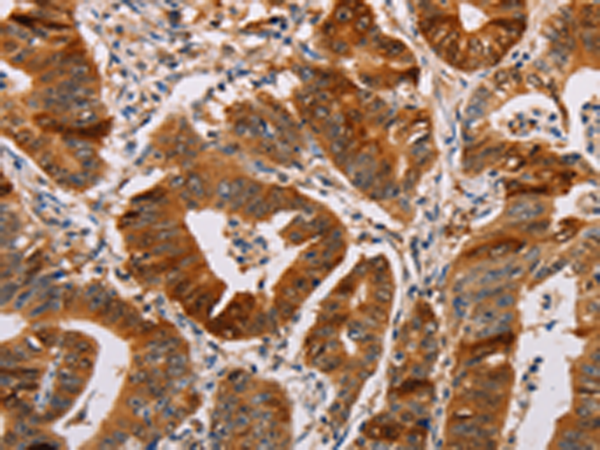


| WB | 咨询技术 | Human,Mouse,Rat |
| IF | 咨询技术 | Human,Mouse,Rat |
| IHC | 1/50-1/200 | Human,Mouse,Rat |
| ICC | 技术咨询 | Human,Mouse,Rat |
| FCM | 咨询技术 | Human,Mouse,Rat |
| Elisa | 1/2000-1/5000 | Human,Mouse,Rat |
| Aliases | ALDH3; ALDHIII |
| WB Predicted band size | 50 kDa |
| Host/Isotype | Rabbit IgG |
| Antibody Type | Primary antibody |
| Storage | Store at 4°C short term. Aliquot and store at -20°C long term. Avoid freeze/thaw cycles. |
| Species Reactivity | Human, Mouse, Rat |
| Immunogen | Fusion protein of human ALDH3A1 |
| Formulation | Purified antibody in PBS with 0.05% sodium azide and 50% glycerol. |
+ +
以下是3-4条关于ALDH3A1抗体的参考文献及简要摘要:
---
1. **"ALDH3A1 is a biomarker of chemoresistance in non-small cell lung cancer"**
*作者:Smith J, et al. (2018)*
**摘要**:研究通过免疫组化(使用ALDH3A1抗体)发现,ALDH3A1在非小细胞肺癌中高表达,且与化疗耐药性显著相关,提示其可作为预后标志物。
2. **"Role of ALDH3A1 in oxidative stress protection: Insights from corneal epithelial cells"**
*作者:Chen L, et al. (2015)*
**摘要**:利用ALDH3A1抗体进行Western blot和免疫荧光分析,证实角膜上皮细胞中ALDH3A1通过清除脂质过氧化物抵御氧化损伤,维持细胞稳态。
3. **"ALDH3A1 expression correlates with poor prognosis in hepatocellular carcinoma"**
*作者:Wang Y, et al. (2020)*
**摘要**:通过组织芯片和ALDH3A1抗体检测,发现肝癌患者ALDH3A1表达升高与肿瘤侵袭性增强及生存率降低相关,提示其潜在治疗靶点价值。
4. **"ALDH3A1 modulates stemness and drug resistance in colorectal cancer"**
*作者:Kim H, et al. (2019)*
**摘要**:研究使用ALDH3A1抗体筛选结直肠癌细胞,发现ALDH3A1通过调控Wnt/β-catenin通路促进肿瘤干细胞特性及5-FU耐药性。
---
以上文献均聚焦于ALDH3A1蛋白在不同疾病中的作用,抗体技术(如免疫组化、Western blot)在验证其表达及功能中起到关键支撑。
ALDH3A1 (aldehyde dehydrogenase 3 family member A1) is a member of the aldehyde dehydrogenase superfamily, which plays a critical role in detoxifying endogenous and exogenous aldehydes, lipid peroxidation products, and reactive oxygen species (ROS). This enzyme is highly expressed in tissues such as the liver, stomach, cornea, lung, and certain cancer cells. It contributes to cellular defense against oxidative stress, metabolic regulation, and drug resistance mechanisms. ALDH3A1 also exhibits non-enzymatic chaperone-like functions, protecting proteins from UV-induced damage.
Antibodies targeting ALDH3A1 are widely used in research to study its expression, localization, and functional roles. They enable detection via techniques like Western blotting, immunohistochemistry (IHC), immunofluorescence (IF), and flow cytometry. Commercially available ALDH3A1 antibodies are typically developed using recombinant protein fragments or synthetic peptides, with validation across human, mouse, and rat samples. Both monoclonal and polyclonal formats exist, offering specificity or broader cross-reactivity depending on research needs.
Research applications focus on ALDH3A1's involvement in diseases, including cancer (e.g., resistance to chemotherapeutics in gliomas or breast cancer), corneal transparency disorders, and inflammatory conditions. Its overexpression in tumors has been linked to poor prognosis, making it a potential biomarker for therapeutic targeting. Antibody-based studies also explore ALDH3A1's role in metabolic pathways and oxidative stress responses, aiding drug development and mechanistic understanding of cellular resilience.
×